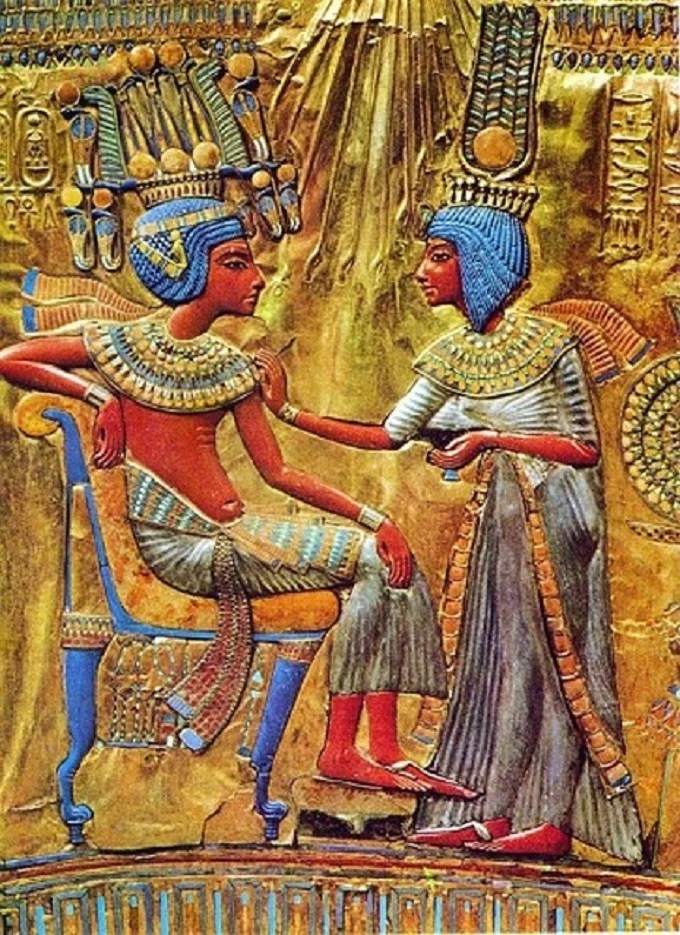The discovery of Tutankhamun’s tomb in 1922 by the British Egyptologist Howard Carter greatly impacted the history of archaeology. It was considered one of the most important discoveries of the century. Almost everyone has heard of the young king, but the tragic life of his wife Ankhesenamun, which is well documented in ancient reliefs and murals from her parents’ reign, is still the greatest mystery for Egyptologist researchers. There are images of her next to the king, but after his death, she seems to have disappeared from the historical record.
Ankhesenamun was born into a very influential family during the 18th dynasty of Egypt. She was the third daughter of the reformist Pharaoh Akhenaten and his equally famous wife, the beautiful Nefertiti. She became the wife of her half-brother, Tutankhamun, at the age of 13, while her husband was only 8 or 10 years old.
She is believed to have been born at Thebes but grew up at Akhetaten (now known as Amarna), the center of the cult of the god Aton, a capital that lasted only about 15 years. Numerous ancient artifacts found by archaeologists confirm this.
In addition, researcher Valérie Angenot, professor of art history and specialist in visual semiotics at the University of Quebec in Montreal, believes that after Nefertiti’s death, Akhenaten married his eldest daughter Meritaton.
The plague struck Egypt during Akhenaten’s roughly 17-year reign (from 1353 to 1335 B.C.). Even Akhenaten’s three daughters died during that time, probably from the plague, Angenot says.
“I believe that because of all these deaths, he was trying to prepare his succession,” Angenot told Live Science. “He was trying to prepare his four surviving children so that they could rule at some point if the others died.”
So, Akhenaten married his eldest daughter Meritaten. Then his second daughter Anhesenpaaten was to marry Tutathamon so that when he became king, she would become queen.
It was very common in ancient Egypt for marriages to take place within the family. It was practiced to protect the royal family. Pharaohs believed that they were descended from the gods, and marriage between close relatives was permissible to preserve the sacred lineage.
Originally Ankhesenamun may have married her father, becoming queen. During their reign, kings or pharaohs had to name their co-ruler, and in the case of Akhenaten, it was Smenhkare. Soon after Akhenaten’s death, Smenhkare became pharaoh and married Anhesenamun. Eventually, Smenhkare also died two or three years later, and finally, Anhesenamun became the wife of Pharaoh Tutankhamun.
Tutankhamun himself died at the age of 19, probably from gangrene that developed after a broken leg. Some scholars have speculated that he may have been murdered, but research conducted on his remains has not confirmed this.
Tutankhamun and Anhesenamun are believed to have had two children (both girls) who were born prematurely and died during their reign. Evidence is provided by the mummified remains of two babies found in Tutankhamun’s tomb, and DNA testing has confirmed that they were Tutankhamun’s daughters.
Pharaoh’s young advisor Ai instantly became king and married Ankhesenamun. Some believe he was her maternal grandfather. Tutankhamun’s funeral was conducted in haste, without observing the burial traditions of the highest rulers.

From this point on, the evidence of Ankhesenamun’s life was cut short. Even an analysis of Ai’s burial could not shed any light on the matter. The walls of the pharaoh’s tomb are decorated with images of Tei, his next wife, but there is nothing about Ankhesenamun. There is no written document about her and no information about her tomb. She disappeared without a trace.
In 2016, archaeologists who scanned Tutankhamun’s tomb said they believed there were undiscovered chambers near the tomb that might contain mummies of Queen Nefertiti or even Ankhesenamun. But a more thorough scan by National Geographic a few months later found no evidence of these chambers. Ankhesenamun disappeared from the historical record sometime between 1325 and 1321 B.C.
According to some reports, after the death of Tutankhamun, Ankhesenamun tried to seek protection from the Egyptian enemies, the Hittites. Archaeologists have discovered a letter to the Hittite king Suppiluliumas I from an unknown royal woman who pleads with him to send her one of his sons and marry her.
Suppiluliumas I then sent his youngest son Zananza to marry the queen of Egypt, but Egyptian troops killed him. It is unknown if this theory is true, but the story of the “Lost Princess of Egypt” is mysterious.
